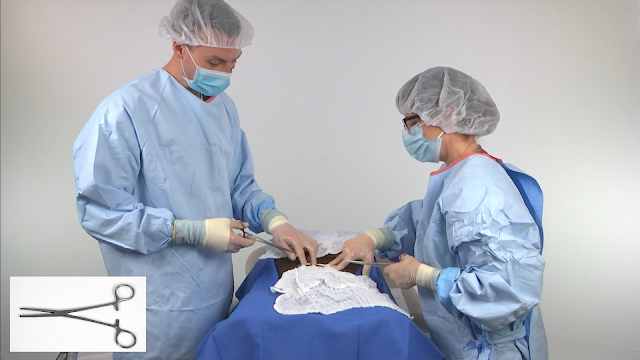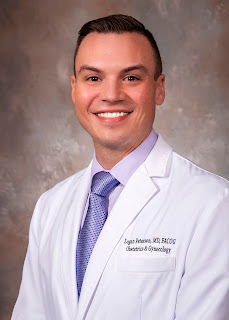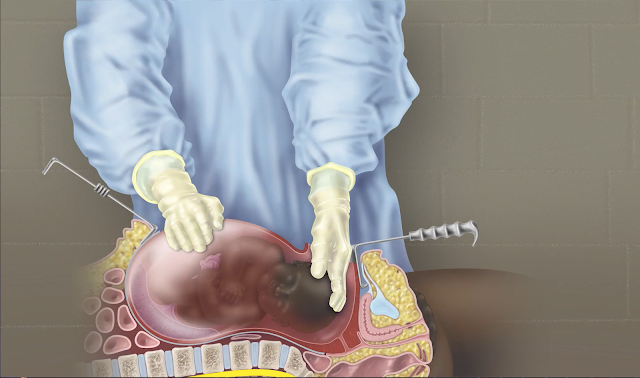Developing Video-Based Instruction for Medical Students Rotating in OB/GYN
The Uniformed Services University's Department of Gynecologic Surgery & Obstetrics (GSO) is making educational videos to assist with student engagement and learning.
 |
| Demonstration of fascial dissection during cesarean delivery. (Photo courtesy of Dr. Logan Peterson, USU) |
July 6, 2023 by Vivian Mason
Video consumption for entertainment, instruction, and education has skyrocketed over the past few years. The Uniformed Services University's Department of Gynecologic Surgery & Obstetrics (GSO) has jumped on the bandwagon, making its own educational videos to assist with student engagement and learning, as well as to provide individualized learning experiences. Most of these medical videos detail surgical procedures for student use.
Multimedia learning has been shown to be effective in clinical skills training in the GSO curriculum. Logan Peterson, M.D., assistant professor of GSO as well as director of clinical clerkships, says, “We’re looking for new ways to communicate with our students and want to reach out to provide educational modalities that will work for them. So, we’ve started creating videos for common procedures that we perform in OB/GYN.”
The plan is to incorporate videos into the clerkships to help students become more comfortable and knowledgeable regarding various procedures and exams.
 |
Logan Peterson, M.D., assistant professor of GSO and director of Clinical Clerkships. (Photo courtesy of Dr. Logan Peterson) |
Enthusiastically, he reports that the students are also very involved in the development/making of various videos. “We promote the videos through the GSO Student Interest Group,” explains Peterson, “as well as through a research/project list that students interested in GSO can review and participate in. Scripts are reviewed by me and other members of the faculty before production.”
Several fourth-year students, as part of their Capstone projects, helped create videos. “They wrote scripts, were involved in filming, assisted with literature search and review, and helped with video planning,” declares Peterson. “One student served as a surgical tech in the video. One other student assisted with the cesarean delivery video. Another student wrote the entire script for the pelvic exam, did the literature search, and acted as the video host.”
“I was more of an ancillary figure,” acknowledges Peterson. “I helped behind the scenes by reviewing the script, providing equipment, guiding the video planning meetings, and directing the filming of the procedure.”
Specific video topics are decided on based upon student feedback. Many USU students expressed an interest in obtaining more exposure to certain clinical skills before and during the clerkships, as well as expressing a desire to become more comfortable with those tasks.
Among third- and fourth-year medical students and residents, YouTube was found to be the most frequently accessed educational video source when students were preparing for surgical-based rotations and procedures. MEDtube, an e-learning platform for health care professionals, has a large repository of multimedia content.
“However, even with these resources,” says Peterson, “students still need to be vigilant about content to ensure that these videos can accurately prepare them for their rotations, which is why we promote usage of the USU-created videos.”
Cesarean section (or C-section) is one of the most commonly performed surgical procedures for which students need to prepare. “Student doctors will most likely participate in an OB/GYN procedure on their very first day of clinical rotations,” explains Peterson. “That’s why we create our own educational videos for teaching this surgical procedure outside of the operating room. We try to adequately prepare our medical students for the procedural portion of their clinical rotations by providing clear, concise video-based instruction.”
The idea for creating a video on C-section came from the GSO medical students and residents at Walter Reed National Military Medical Center.
“[The students and residents] wanted a video that was evidence-based to help standardize what the procedure should look like,” says Peterson. Thus, using information from published scientific articles, they created a script that included the important steps involved in the procedure, including what evidence will or will not improve patient outcomes. Those key steps were identified from the articles in order to highlight them in the video.
From the created script, the GSO team worked with graphic artists and illustrators from USU’s Education and Technology Innovation (ETI) Support Office to film the video in their studio. There, the team collaborated with ETI on the editing process, as well as completed voiceovers and inserted screen displays to make it a fluid video.
“The ETI team is wonderful,” remarks Peterson. “They’re very experienced with all of this and helped us out along the way. They’re so full of ideas and approaches that we hadn’t even considered.” After several revisions, a 30-minute video was born.
“Interestingly, in the video, we used a model that was validated for teaching cesarean delivery,” says Peterson. “Previously, we had performed a study on that model with OB/GYN interns and general surgery residents to validate its utility.”
Completed videos are available through the GSO clerkship learning management system page and are accessible to USU clerkship students.
 |
| Delivery of fetus showing hand and instrument placement. (Graphic courtesy of Dr. Logan Peterson, USU) |
“Currently, we’re in the process of creating an Institutional Review Board protocol for the C-section video’s impact on students,” claims Peterson. “We’re doing research on the video to see what we can do better and how we can make it as educational as possible.”
Overall, GSO has completed two videos and has two to three more in the works. These videos teach procedures, and allow the students the opportunity to pause, speed up, or slow down the information. Students can also review material or re-watch videos as often as needed.
The major challenge when creating a medical education video is to identify the learning objectives.
“Coming up with the subject of a video is the easy part,” says Peterson. “Identifying solid, tangible learning objectives and ensuring that they are met is the challenging part of video creation.” Also, it’s necessary to consider how to stage things in order to maximize engagement by the students.
Animation is sometimes incorporated into videos to show what’s going on in the human body, as well as help translate complex visual information. It allows the user to visualize structures or movements that are not well visualized or understood using just the video alone. Animation can also be used to make a video more interactive.
“Presently, I’m working with a student on an intrauterine device insertion video,” explains Peterson. “We’re going to review the counseling and placement procedures for the two major types of IUDs. This is an exceptionally common procedure, but one many medical students only get to watch due to the nature of placement and the potential for complications. We’re in the process of revising the script, but our hope is to have it finished by spring.”
Peterson enjoys interacting with the students. “I like to see the excitement in their eyes when they’re finally getting to do what they came here to do: see patients. Clerkship is one of the first opportunities that they get to do that. So, it’s wonderful to see it happen.”
What intrigues him the most about medical education is the ability to be creative. “There’s so much potential for change and new ideas. I love looking at what we do and how we teach our students. I appreciate interacting with my team and talking about what we’re doing and how we can make things better. I relish reaching out to our students and making sure they’re getting what they need.”

